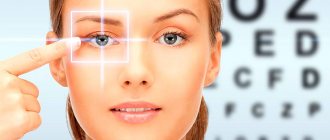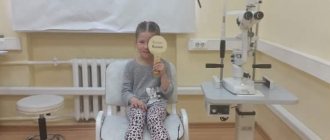The number of children with poor vision is growing every year. At the same time, such statistics are observed in almost all countries. Many people tend to blame computers and phones that children use, especially in adolescence. However, there are many more reasons for vision impairment in children and adolescents.
Just a few decades ago, the most frequent visitors to the ophthalmologist’s office were mature and elderly people. Today, ophthalmologists talk about the “rejuvenation” of this problem. Increasingly, their patients are children.
Vision deteriorates in children for various reasons. There are quite a lot of them. Knowing many of them, you can prevent severe visual pathologies that greatly worsen the child’s quality of life. We will find out why visual functions decline in childhood, what symptoms accompany this decline, and what parents should do if their child’s vision has deteriorated.
Why does children's vision deteriorate?
Vision in children deteriorates due to two factors: congenital and acquired. The first include:
1. Hereditary predisposition. A child is more likely to be nearsighted, farsighted, or astigmatic if one or both of their parents suffers from one of these eye conditions. 2. Prematurity. According to medical statistics, in about a third of children born prematurely, their vision deteriorates over the years. 3. Congenital pathologies and eye defects. Diseases such as cerebral palsy, hydrocephalus and many others can be accompanied by visual defects.
It is impossible to prevent all causes. If there is a possibility of their occurrence, children should be examined more often. Regular examinations with an ophthalmologist and compliance with all doctor’s instructions will help stop the development of visual pathology.
Among the acquired reasons:
- Large and constant loads on the visual apparatus. Children have to read constantly. They go to school, do homework, and therefore spend most of their time with books and notebooks. Prolonged strain caused by focusing on objects close to the eyes leads to increased intraocular pressure. It causes changes in the shape of the lens, which leads to vision problems. Today, computers and various gadgets increase eye strain. It is practically impossible to prohibit children from using them. And it is not advisable to do this, because the Internet and computer play an important role in obtaining the information necessary for education. Parents should monitor how their child is studying, whether his workplace is properly organized, and also limit the time he spends in front of the monitor.
- Bad light. This reason is related to the previous one. It is necessary that the lighting in which the child studies is not too bright and not too dim. The pages of a notebook, book, or monitor should not create glare from the light falling on them.
- Spinal diseases and incorrect posture. There are also a lot of factors that lead to a decrease in visual acuity, but which are not directly related to the eyes. Thus, incorrect posture and diseases of the spine can provoke visual pathologies. With constant stooping, blood circulation in all organs, including the brain, worsens. As a result, the conductivity of the nerve fibers responsible for transmitting signals from the organs of vision to the brain is disrupted. To treat the baby, you will need the help of an orthopedist and a neurologist.
- Low physical activity. Computers and smartphones are replacing games in the yard, sports and other activities related to physical activity, during which the organs are saturated with oxygen. Lack of oxygen is one of the main causes of decreased vision. If there is a genetic predisposition to eye diseases, sport becomes a good barrier to the occurrence of visual defects.
- Lack of vitamins. Among the vitamins and minerals that play a significant role in the functioning of vision: folic acid, iron, zinc, vitamins A, B, D. It is difficult to keep track of what a child eats outside the home. Chips, sandwiches, chewing gum and soda are not healthy products in principle. To reduce the harmful effects of such junk food on his body, you need to create a proper diet at home.
- Lack of prevention. All of the above factors can be leveled out through preventive measures, which many parents neglect due to lack of time and other reasons.
Now you know why vision deteriorates in children. This problem manifests itself in various ophthalmological diseases.
What to do if you are nearsighted
How to restore vision with myopia? Myopia or myopia is a pathological condition of the eye organ in which a person sees objects located nearby well, but poorly sees objects located in the distance.
Myopia is common in young people; severe changes require wearing glasses or contacts. For myopia, use physical gymnastics and reduce the intensity of activities that strain the eyes.
The following exercises are used for recovery:
- frequent blinking;
- variable focusing on an object near and far;
- self-massage.
Myopia is reluctant to respond to conservative treatment. The use of gymnastics is advisable only for mild to moderate disorders. Often, with the help of gymnastics, it is only possible to stop the development of the disease. A person suffering from severe myopia must wear glasses or contacts. A highly effective treatment method is laser correction.
The results of conservative therapy become noticeable after a few months. A positive result is considered to be slowing or stopping the development of pathology.
If you are nearsighted, you will need to do special exercises every day. It only takes 5 minutes a day and has enormous benefits.
Types of visual impairment in children and adolescents
The most common visual impairments are the following pathologies:
- Spasm of accommodation. This condition is also called false myopia. It is caused by fatigue of the visual apparatus. As a result of spasm of the eye muscles, the eye cannot focus on objects normally. It may be accompanied by redness of the eyes, pain, burning, and lacrimation. The spasm of accommodation is temporary. It is enough to give your eyes a little rest, do a massage of the eyeballs or a few exercises for the visual organs. However, if left untreated, this problem can develop into a more serious illness - myopia.
- Myopia (myopia). With this pathology, it is difficult for a person to focus on objects at a long distance. Myopia can progress very quickly. There are three degrees of this disease. It is important to stop its development at the initial stage.
- Farsightedness (hypermetropia). It is less common in children and adolescents than myopia. Usually a person is born slightly farsighted, but over time the vision normalizes. If this does not happen, and you begin to notice that your child moves a book or phone away from him when reading, be sure to make an appointment with an ophthalmologist.
- Astigmatism. With this pathology, the cornea, lens or eyeball have an irregular shape. Light rays passing through the cornea are refracted differently. This causes the image to become blurry. Often, astigmatism is accompanied by myopia or hypermetropia.
- Amblyopia, or “lazy eye” syndrome, is a disease in which one eye is completely or partially unable to function. Amblyopia is observed in children with binocular impairment. In this condition, the images entering the brain that are seen by both eyes are not combined into a single image. It begins to double and blur. Over time, one eye may stop working altogether.
Each of these pathologies requires timely treatment. Visual defects such as myopia, hypermetropia and astigmatism are corrected by means of correction (glasses or contact lenses). Amblyopia is treated using the occlusion method (closing the healthy eye temporarily with a special plate). It is important to notice a decrease in a child’s vision in time in order to take appropriate measures.
Returning vision to a child
Often a child experiences deterioration in eye sharpness. Before the age of 10, a small percentage of people experience problems with this. If visual perception deteriorates, one of the parents and the child visit a pediatric ophthalmologist.
They do this to exclude pathological and dangerous conditions. The recovery technique is exactly the same as for people of other ages, but there are some features, for example, it is more difficult to force a child to do the exercises.
Deteriorating vision in a child is difficult to control. Children rarely talk about problems. For control, they visit clinics that have means for accurate diagnosis. Modern centers use computer diagnostic devices to assess the condition of the eyeball.
Performing exercises can be presented as a game:
- Game of blind man's buff. Ask your child to close their eyes with their head elevated for 6 seconds. The action is repeated 5-6 times.
- Massage your eyelids. Massaging closed eyelids improves blood circulation and promotes relaxation.
- Keep an eye on the subject. Take the toy and ask him to keep an eye on it. The child should move his eyes in a circle, up and down, diagonally.
If you start doing gymnastics in time, you will be able to restore visual acuity.
The child's vision deteriorates. What to do?
You cannot select ophthalmic products yourself. Incorrectly selected optics can lead to complications and will simply cause discomfort to the child.
Ignoring symptoms can also cause severe and irreversible consequences. There are signs of decreased vision that can be seen with the naked eye. Among them:
- the child constantly squints and blinks frequently;
- eyes look in different directions;
- the baby systematically closes one eye with his hand;
- while reading, the student runs his finger along the lines;
- coordination of movements is impaired.
These symptoms can be easily noticed by an adult when observing their child. Also, the child himself may complain about:
- headache;
- eye fatigue;
- double vision;
- dizziness when there is strain on the visual organs.
Of course, these symptoms can be caused by ordinary overwork and lack of sleep. Double vision and pain are caused, for example, by foreign objects getting into the eyes. Constant complaints or the presence of several symptoms (at least two) are a reason to visit a doctor.
Prevention of visual impairment in children and adolescents
To prevent eye diseases, you need to undergo regular examinations. The first diagnosis of the visual organs is carried out immediately after birth. At approximately 2-3 years of age, visual acuity is determined, strabismus and amblyopia are detected. A detailed examination of the vision of adolescents is carried out at the age of 12-13, when it is necessary to check binocular functions and color perception.
You should visit an ophthalmologist at least once a year.
Schools usually organize routine inspections every year. In addition to examinations, it is important to follow all the doctor’s recommendations that will help reduce the risk of developing ophthalmic diseases. The basic instructions of specialists boil down to compliance with a number of rules:
- Rest. Every 40 minutes you need to stop studying to give your eyes a rest. It is no coincidence that a lesson at school lasts 40-45 minutes. You can rest more often at home. About every half hour, parents should ensure that their child looks up from his textbooks or computer for one to two minutes.
- Correct lighting. The table lamp should not be very bright. The light should not shine directly on your eyes or on a computer monitor. Otherwise, glare and halos will form.
- Eye hygiene. Parents should teach children from an early age to hygiene, which affects not only eye health, but also immunity in general.
- Sport. It helps improve health and distract the child from computer games and TV.
- Proper nutrition. To improve vision and prevent a decrease in its sharpness, doctors advise consuming foods containing carotenoids, lutein, and zeaxanthin. They restore visual function in case of fatigue, reduce the effects of eye strain, improve color perception and vision in the dark. A person should receive all the necessary substances from regular food. If there is a deficiency, the doctor may prescribe a vitamin complex.
- Gymnastics for the eyes. Young children will not do eye exercises on their own. Adults should interest the child in this and conduct gymnastics in the form of a game. Teenagers can do the exercises themselves. The parents’ task is to motivate them and explain that gymnastics is an opportunity to avoid vision problems and the need to wear glasses. There are many exercises for preschoolers, primary school children and teenagers. You can find them on the Internet. An ophthalmologist will also advise you on the appropriate method.
- Wearing computer glasses. They can be purchased at any optical shop or specialized online store. The child must get used to using them and wear them constantly before sitting down at the computer.
Healthy vision of children is the key to school performance, success in sports achievements and the full development of the child. It is necessary to take care of eye health from early childhood in order to avoid long-term treatment and serious consequences later.
What problems does a child face with myopia?
Symptoms of myopia cause a lot of problems for a child. Decreased vision and the inability to clearly see distant objects are not the only inconveniences that many children face. The development of myopia is accompanied by frequent headaches, discomfort in the eyes, and difficulty concentrating.
If you do not begin to correct myopia in a timely manner, binocular vision may be impaired. The child loses the ability to see clearly with both eyes. The consequence of myopia is often strabismus and amblyopia - “lazy eye”. The most serious complications are detachment and degeneration of the retina or vitreous. Aesthetics play an important role in the development of myopia. The child is forced to wear glasses, which often become a source of ridicule. Contact lenses are more convenient in this regard, but not all children know how to handle them correctly and can harm their visual organs if they do not follow the care rules.











